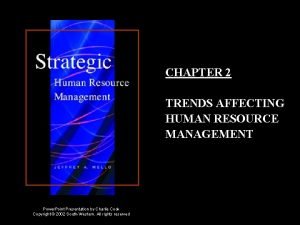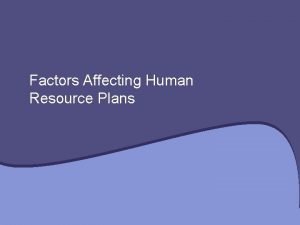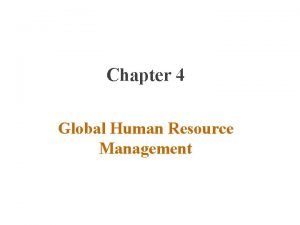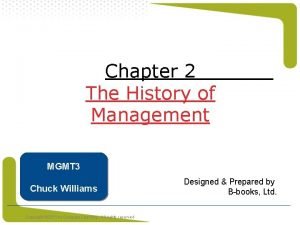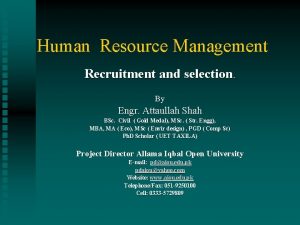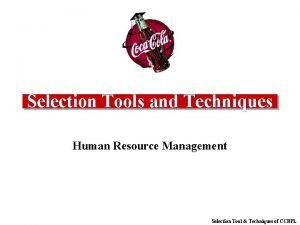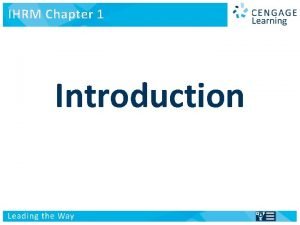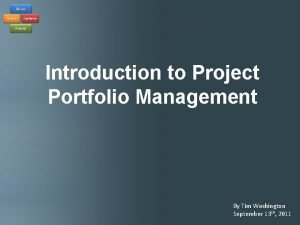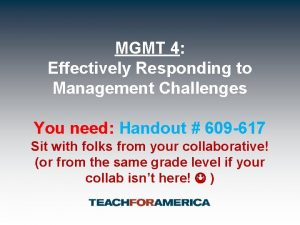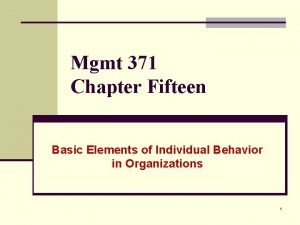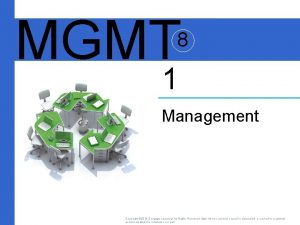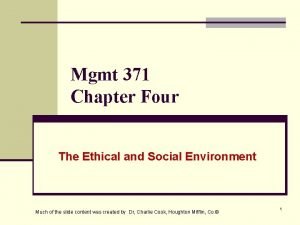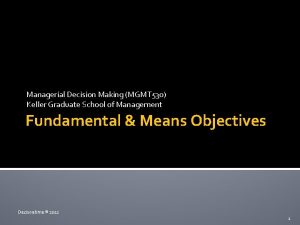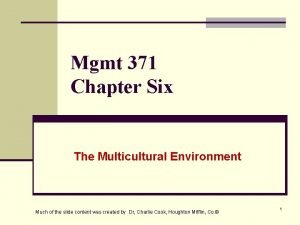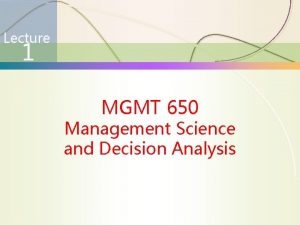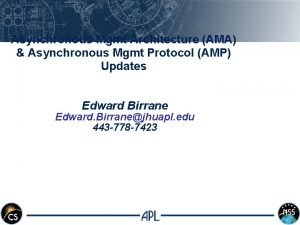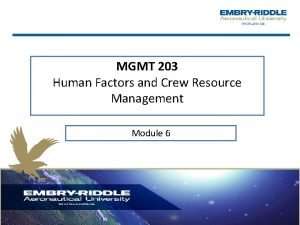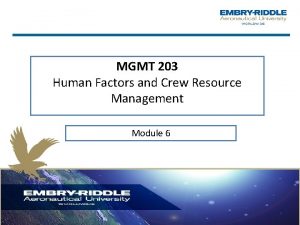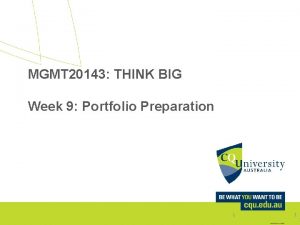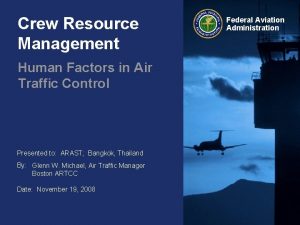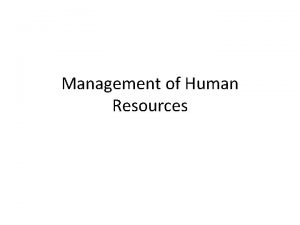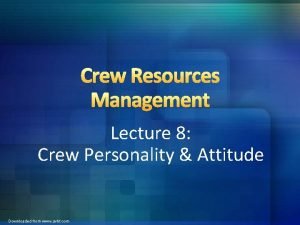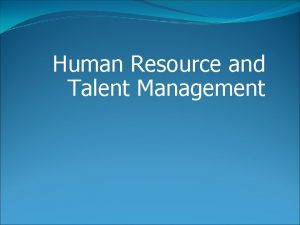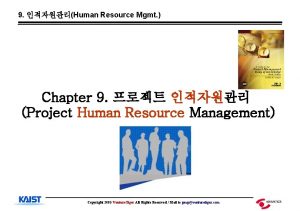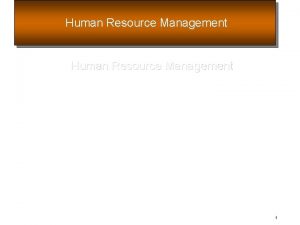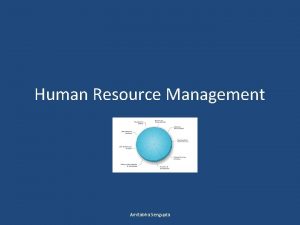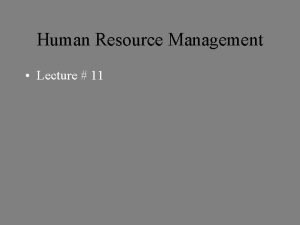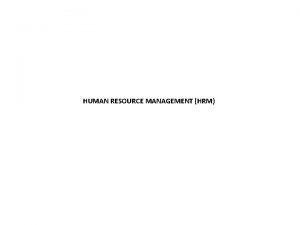MGMT 203 Human Factors and Crew Resource Management































- Slides: 31

MGMT 203 Human Factors and Crew Resource Management Module 6

THIS DAY IN AVIATION • • October 31 1921 — United States Navy hydroairplane is launched from catapult.

THIS DAY IN AVIATION • • October 31 1921 — American Legion Flying Meet, during National Convention at Kansas City, Missouri, has 100 planes participating. Curtiss and Larsen J. L-6 planes with passengers fly from New York prior to the events.

THIS DAY IN AVIATION • • October 31 1933 — France's air minister Pierre Cot formally inaugurates the country's national airline, Air France.

THIS DAY IN AVIATION • October 31 • 1939 — The Mackay Army Trophy for 1938 is nd presented to the 2 Bombardment Group, Langley Field, Virginia by the Secretary of War, Harry H. Woodring. • The trophy was won as a result of the efficient and successful completion of the flight of six Boeing B-17 “Flying Fortresses” from Langley Field, Virginia, to Buenos Aires, Argentina, and return during February, 1938.

THIS DAY IN AVIATION • October 31 • 1939 — Comdr. Humberto Gallino and Capt. Victor Gallino, Peruvian brothers, land on Puna Island, Ecuador, in the Gulf of Guayaquil off Ecuador , after flying approximately 3, 300 miles, from New York, which they left on 29 October in a Barkley-Grow monoplane , powered by 2 Pratt & Whitney “Wasp Junior” engines. • Lack of fuel forced the plane to land short of Lima, Peru, its goal.

THIS DAY IN AVIATION • October 31 • 1956 — The US Navy R 4 D-5 “Skytrain” Que Sera, commanded by Rear Admiral George Dufek, becomes the first airplane to make a landing at the South Pole.

THIS DAY IN AVIATION • • October 31 1968 — President Johnson orders a halt to bombing of North Vietnam.

Questions / Comments

October 2017 SUNDAY MONDAY TUESDAY WEDNESDAY THURSDAY FRIDAY SATURDAY 15 16 17 18 19 20 21 Module 5 Intro Aviation Safety and Security Flightline Aviation Safety and Friday Security 28 Aviation Safety and Security 22 23 24 25 26 27 Module 5 Mighty 8 th Aviation Safety and Security Beaufort County Airport (ILT) 29 30 31 1 2 3 4 Module 6 Flightline Intro Human Factors and CRM Human Factors and Friday CRM Human Factors and CRM Review Questions Due Discussions Due 5 6 7 8 9 10 11 Module 6 Human Factors and CRM Beaufort County Airport (ILT) Flightline Friday Human Factors and CRM Discussion Due Review Questions Due

Management of Aeronautical Science Learning Objectives – Module 6 (10/30/17 – 11/10/17) Human Factors and Crew Resource Management Upon successful completion of this module, you will be able to: 1. Explain the aeromedical factors that are essential features in the lives of aviation professionals. 2. Classify the principles of the Aeronautical Decision Making (ADM) model include DECIDE. 3. Describe human factors design considerations that must be considered in flight deck design. 4. Describe the evolving concepts of Crew Resource Management. 5. Differentiate among the topics that are typically included in current CRM programs. 6. Analyze CRM performance marker clusters for their applicability to different crew situations. 7. Describe the goals associated with Maintenance Resource Management (MRM). 8. Discuss the principles of Dr. James Reason's Swiss Cheese Model. 9. Explain the Sterile Flight Deck or Cockpit rule and why is it important. 10. Discuss human factors design considerations.

Readings • Refer to Readings on ERAU Website Mod 6 • FAA AC 120 -51 E Crew Resource Management Training • Pilots Handbook of Aeronautical Knowledge – Chapter 17 – Aeromedical Factors – Chapter 2 – Aeronautical Decision Making • Title 14 Code of Federal Regulations (CFR) - Please review 14 CFR Parts: – 121 and 135. • Textbook – Business and Corporate Aviation Management – Chapter 6: Operations

6. 3 a - NTSB Case Study (Part 1) Wed Nov 8

6. 3 b - NTSB Case Study (Part 2) Wed Nov 8

Module 6 Review Questions (Due Fri Nov 10) • Spend quality time responding to the following questions in your own words. 1. Explain the aeromedical factors that are essential features in the lives of aviation professionals. 2. Classify the principles of the Aeronautical Decision Making (ADM) model and DECIDE (Detect, Estimate, Choose, Identify, Do, Evaluate) model. 3. Describe human factors design considerations that must be considered in flight deck design. What is the importance of this concept ? 4. What are the evolving concepts of Crew Resource Management (CRM)? 5. Describe the goals associated with Maintenance Resource Management (MRM). 15

Term Paper Topics DUE Friday Dec 8, 2017 Aircraft Manufacturing Management - Chris Corbett Fire and Crash Rescue Management - Trent Thompson Helicopter Operations Management - Casey Bradford Your Final Term Paper must be at least 12 pages and consist of the following: A title page Main text (10 pages) Reference page (current APA format) The paper should include some of the headings below as appropriate: Introduction Description of the Company or Agency (Basically what business are you in) Operation Description Equipment or Aircraft Maintenance Requirements Manager’s Roles and Responsibilities Staff Qualifications, Certifications, and Responsibilities Human Factors Quality Requirements Regulations and Laws Safety Security Environmental Responsibilities Other Management Factors Considered References (current APA format)

Management of Aeronautical Science Assignments Due – Module 6 (10/30/17 – 11/10/17) • Review Module 6 Instructions for the following assignments: • Discussion Board Due (NTSB Case Study 1 and 2) – (Due – Wed Nov 8) – 2 part (Post and Respond) • Review Questions – Human Factors and CRM – (Due – Fri Nov 10) – 5 Questions

Questions / Comments

Crew Resource Management (CRM) • Initially called Cockpit Resource Management. • Issues were identified by flight deck voice recorders (incident and accident investigation). • Enhance pilots skills and interactive training with other team members. • Principles are expanding and new concepts are explored. • 14 CFR Part 135 and Part 121 covers Crew Resource Management training. 19

Crew Resource Management (CRM) • Applied to any activity involving a team, equipment, and a dynamic situation. • Allows individual to improve teamwork. • Concentrates on crewmember attitudes and behaviors. • Provides an opportunity for individuals to examine their behaviors.

AC 120 -51 E Crew Resource Management Training • Guidelines for developing, implementing, reinforcing, and CRM training – Flight crewmembers – Other personnel essential to flight safety • Application of crew team management concepts in decision making. • Back to basics: Excellent communication, group decision making, leadership, and task or resource management. • Common use of Line Oriented Flight Training schedules (LOFT) for integration. 21

AC 120 -51 E Crew Resource Management Training • Review Behavioral Markers under each Cluster – Communications Processes and Decision Behavior Cluster • • • Briefings: safety and security Inquiry/Advocacy/Assertion Crew self-critique regarding decisions and actions Communications and Decisions Other considerations – Conflict resolution – Interpersonal communication – External factors and barriers

AC 120 -51 E Crew Resource Management Training • Review Behavioral Markers under each Cluster – Team Building and Maintenance Cluster • Leadership Followership/Concern for Tasks • Interpersonal Relationships/Group Climate – Workload Management and Situational Awareness Cluster • Preparation/Planning/Vigilance • Workload Distribution/Distractions Avoided – (AC 120 -51, 2004, Appendix 1, pp. 1 -5)

The Dirty Dozen Leading to Maintenance Errors • Identified by a study performed by Transport Canada 1. Lack of Communication 2. Lack of Teamwork 3. Lack of Assertiveness 4. Complacency 5. Fatigue 6. Stress 7. Lack of Resources

The Dirty Dozen Leading to Maintenance Errors 8. Lack of Awareness 9. Lack of Knowledge 10. Pressure 11. Distraction 12. Norms – (Sheehan, 2013, p. 282)

Maintenance Resource Management (MRM) • Developed to address teamwork deficiencies in aviation maintenance. • Dirty dozen provided stimulus for training that was required. • Problem resolution based on open and honest communication among all maintenance stakeholders. • 14 CFR Part 121 and Part 135 - Maintenance training program. 26

Maintenance Resource Management (MRM) • Stresses teamwork and a philosophy toward error -free maintenance performance. • Create a positive safety culture throughout the organization. • Goal is to integrate maintenance technical skills, interpersonal skills, and human factors knowledge into excellent maintenance performance. • Detailed information in AC 120 -72 Maintenance Resource Management Training. 27

Maintenance Resource Management (MRM) • Similar to CRM with same themes – Open communications • Issue with shift change briefings – – – Teamwork Situational Awareness Paying attention to detail Problem solving and troubleshooting Safety first (Team based safety behavior) Task allocation 28

Reason’s Swiss Cheese Model • Dr. James Reason's Model of Accident Causation. • Focus is on understanding incidents and accidents and their contributing factors. • Traces the root causes of accidents to higher management levels. • Used in all types of accidents. • If the holes align, the result is an accident. 29

Reason’s Swiss Cheese Model Rodrigues & Cusick. (2012). Commercial Aviation Safety. p. 142 30

Questions / Comments
 Resource management guide 203
Resource management guide 203 Factors affecting human resource management
Factors affecting human resource management Factors affecting human resource management
Factors affecting human resource management Staffing policy
Staffing policy Chapter 2 history of management
Chapter 2 history of management Time management in human resource management
Time management in human resource management Organised retailing
Organised retailing Role of personnel management
Role of personnel management Human resource planning question paper
Human resource planning question paper Strategic human resource
Strategic human resource Follow demand exactly
Follow demand exactly Payroll cycle activities
Payroll cycle activities Selection in human resource management
Selection in human resource management Hr selectietool
Hr selectietool Difference between hrm and ihrm
Difference between hrm and ihrm Infrastructure mgmt
Infrastructure mgmt Professional portfolio management tim washington
Professional portfolio management tim washington Tfanet
Tfanet Mgmt 371
Mgmt 371 Mgmt+8
Mgmt+8 Mgmt 371
Mgmt 371 Keller graduate school of mgmt
Keller graduate school of mgmt Mgmt 341
Mgmt 341 Mgmt 371 final exam
Mgmt 371 final exam Mgmt 650 quiz 4
Mgmt 650 quiz 4 Locational break even analysis
Locational break even analysis Mgmt ama
Mgmt ama Mgmt ama
Mgmt ama Actuary roadmap
Actuary roadmap Apollo ship management
Apollo ship management Slc fsdo
Slc fsdo Resource management pmp
Resource management pmp

